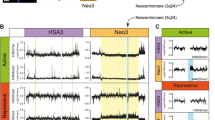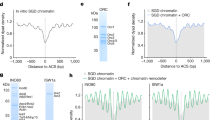Abstract
Heterochromatin in eukaryotic genomes regulates diverse chromosomal processes including transcriptional silencing1. However, in Schizosaccharomyces pombe RNA polymerase II (RNAPII) transcription of centromeric repeats is essential for RNA-interference-mediated heterochromatin assembly2,3,4,5. Here we study heterochromatin dynamics during the cell cycle and its effect on RNAPII transcription. We describe a brief period during the S phase of the cell cycle in which RNAPII preferentially transcribes centromeric repeats. This period is enforced by heterochromatin, which restricts RNAPII accessibility at centromeric repeats for most of the cell cycle. RNAPII transcription during S phase is linked to loading of RNA interference and heterochromatin factors such as the Ago1 subunit of the RITS complex6 and the Clr4 methyltransferase complex subunit Rik1 (ref. 7). Moreover, Set2, an RNAPII-associated methyltransferase8 that methylates histone H3 lysine 36 at repeat loci during S phase, acts in a pathway parallel to Clr4 to promote heterochromatin assembly. We also show that phosphorylation of histone H3 serine 10 alters heterochromatin during mitosis, correlating with recruitment of condensin that affects silencing of centromeric repeats. Our analyses suggest at least two distinct modes of heterochromatin targeting to centromeric repeats, whereby RNAPII transcription of repeats and chromodomain proteins bound to methylated histone H3 lysine 9 mediate recruitment of silencing factors. Together, these processes probably facilitate heterochromatin maintenance through successive cell divisions.
This is a preview of subscription content, access via your institution
Access options
Subscribe to this journal
Receive 51 print issues and online access
$199.00 per year
only $3.90 per issue
Buy this article
- Purchase on Springer Link
- Instant access to full article PDF
Prices may be subject to local taxes which are calculated during checkout




Similar content being viewed by others
References
Grewal, S. I. & Jia, S. Heterochromatin revisited. Nature Rev. Genet. 8, 35–46 (2007)
Volpe, T. A. et al. Regulation of heterochromatic silencing and histone H3 lysine-9 methylation by RNAi. Science 297, 1833–1837 (2002)
Cam, H. P. et al. Comprehensive analysis of heterochromatin- and RNAi-mediated epigenetic control of the fission yeast genome. Nature Genet. 37, 809–819 (2005)
Djupedal, I. et al. RNA Pol II subunit Rpb7 promotes centromeric transcription and RNAi-directed chromatin silencing. Genes Dev. 19, 2301–2306 (2005)
Kato, H. et al. RNA polymerase II is required for RNAi-dependent heterochromatin assembly. Science 309, 467–469 (2005)
Verdel, A. et al. RNAi-mediated targeting of heterochromatin by the RITS complex. Science 303, 672–676 (2004)
Jia, S., Kobayashi, R. & Grewal, S. I. Ubiquitin ligase component Cul4 associates with Clr4 histone methyltransferase to assemble heterochromatin. Nature Cell Biol. 7, 1007–1013 (2005)
Morris, S. A. et al. Histone H3 K36 methylation is associated with transcription elongation in Schizosaccharomyces pombe . Eukaryot. Cell 4, 1446–1454 (2005)
Hall, I. M. et al. Establishment and maintenance of a heterochromatin domain. Science 297, 2232–2237 (2002)
Alfa, C., Fantes, P., Hyams, J., McLeod, M. & Warbrick, E. Experiments with Fission Yeast: A Laboratory Course Manual (Cold Sping Harbor Laboratory Press, Cold Spring Harbor, New York, 1993)
Kim, S. M. & Huberman, J. A. Regulation of replication timing in fission yeast. EMBO J. 20, 6115–6126 (2001)
Nicolas, E. et al. Distinct roles of HDAC complexes in promoter silencing, antisense suppression and DNA damage protection. Nature Struct. Mol. Biol. 14, 372–380 (2007)
Nakayama, J., Rice, J. C., Strahl, B. D., Allis, C. D. & Grewal, S. I. Role of histone H3 lysine 9 methylation in epigenetic control of heterochromatin assembly. Science 292, 110–113 (2001)
Buhler, M., Verdel, A. & Moazed, D. Tethering RITS to a nascent transcript initiates RNAi- and heterochromatin-dependent gene silencing. Cell 125, 873–886 (2006)
Fischle, W. et al. Regulation of HP1-chromatin binding by histone H3 methylation and phosphorylation. Nature 438, 1116–1122 (2005)
Hirota, T., Lipp, J. J., Toh, B. H. & Peters, J. M. Histone H3 serine 10 phosphorylation by Aurora B causes HP1 dissociation from heterochromatin. Nature 438, 1176–1180 (2005)
Yamada, T., Fischle, W., Sugiyama, T., Allis, C. D. & Grewal, S. I. The nucleation and maintenance of heterochromatin by a histone deacetylase in fission yeast. Mol. Cell 20, 173–185 (2005)
Nakayama, J., Klar, A. J. & Grewal, S. I. A chromodomain protein, Swi6, performs imprinting functions in fission yeast during mitosis and meiosis. Cell 101, 307–317 (2000)
Hirano, T. Condensins: organizing and segregating the genome. Curr. Biol. 15, R265–R275 (2005)
Sutani, T. et al. Fission yeast condensin complex: essential roles of non-SMC subunits for condensation and Cdc2 phosphorylation of Cut3/SMC4. Genes Dev. 13, 2271–2283 (1999)
Giet, R. & Glover, D. M. Drosophila aurora B kinase is required for histone H3 phosphorylation and condensin recruitment during chromosome condensation and to organize the central spindle during cytokinesis. J. Cell Biol. 152, 669–682 (2001)
Oliveira, R. A., Coelho, P. A. & Sunkel, C. E. The condensin I subunit Barren/CAP-H is essential for the structural integrity of centromeric heterochromatin during mitosis. Mol. Cell. Biol. 25, 8971–8984 (2005)
Meyer, B. J. Sex in the wormcounting and compensating X-chromosome dose. Trends Genet. 16, 247–253 (2000)
Saka, Y. et al. Fission yeast cut3 and cut14, members of a ubiquitous protein family, are required for chromosome condensation and segregation in mitosis. EMBO J. 13, 4938–4952 (1994)
Zofall, M. & Grewal, S. I. HULC, a histone H2B ubiquitinating complex, modulates heterochromatin independent of histone methylation in fission yeast. J. Biol. Chem. 282, 14065–14072 (2007)
Horn, P. J., Bastie, J. N. & Peterson, C. L. A. Rik1-associated, cullin-dependent E3 ubiquitin ligase is essential for heterochromatin formation. Genes Dev. 19, 1705–1714 (2005)
Schramke, V. et al. RNA-interference-directed chromatin modification coupled to RNA polymerase II transcription. Nature 435, 1275–1279 (2005)
Li, B., Carey, M. & Workman, J. L. The role of chromatin during transcription. Cell 128, 707–719 (2007)
Motamedi, M. R. et al. Two RNAi complexes, RITS and RDRC, physically interact and localize to noncoding centromeric RNAs. Cell 119, 789–802 (2004)
Murzina, N., Verreault, A., Laue, E. & Stillman, B. Heterochromatin dynamics in mouse cells: interaction between chromatin assembly factor 1 and HP1 proteins. Mol. Cell 4, 529–540 (1999)
Acknowledgements
We thank M. Yanagida for strains, and B. Strahl and C. D. Allis for antibodies. We also thank K. Tomita and X. Chen for technical help, T. Fischer for help with microarray data analysis, and other members of the Grewal laboratory for discussions. This research was supported by the Intramural Research Program of the National Institutes of Health, National Cancer Institute.
Author information
Authors and Affiliations
Corresponding author
Supplementary information
TITLE
This file contains Supplementary Figures 1-10 with Legends. The Supplementary Figures show results from conventional ChIP, RT-PCR, serial dilution and Northern analyses that complement data presented in primary Figures 1-4. (PDF 847 kb)
Rights and permissions
About this article
Cite this article
Chen, E., Zhang, K., Nicolas, E. et al. Cell cycle control of centromeric repeat transcription and heterochromatin assembly. Nature 451, 734–737 (2008). https://doi.org/10.1038/nature06561
Received:
Accepted:
Published:
Issue Date:
DOI: https://doi.org/10.1038/nature06561
This article is cited by
-
Structural and functional specificity of H3K36 methylation
Epigenetics & Chromatin (2022)
-
Rbm10 facilitates heterochromatin assembly via the Clr6 HDAC complex
Epigenetics & Chromatin (2021)
-
H3K36 methylation reprograms gene expression to drive early gametocyte development in Plasmodium falciparum
Epigenetics & Chromatin (2021)
-
Emerging roles of centromeric RNAs in centromere formation and function
Genes & Genomics (2021)
-
FA-SAT ncRNA interacts with PKM2 protein: depletion of this complex induces a switch from cell proliferation to apoptosis
Cellular and Molecular Life Sciences (2020)
Comments
By submitting a comment you agree to abide by our Terms and Community Guidelines. If you find something abusive or that does not comply with our terms or guidelines please flag it as inappropriate.



